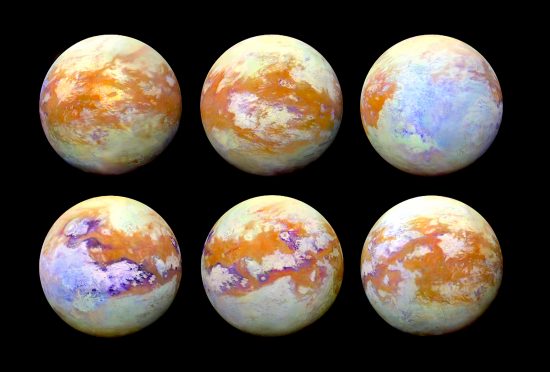
June 17, 2020
According to a recent journal publication, “A team of researchers…has found evidence that suggests the bright patches spotted on Titan’s surface 20 years ago are dry lake beds.”
The formerly named Cassini-Huygens mission was launched from Cape Canaveral on October 15, 1997. Few now remember the public outcry against the mission. There were several attempts by citizens groups to stop the launch because of the 33 kilograms of plutonium-238 that provides electrical power to the orbiter. Since there had been failures of other launch vehicles, the concern was that an explosion of the Titan IV-B rocket would scatter radiation over many hundreds of square kilometers in southern Florida.
However, the launch was uneventful, and after several years flight time Cassini entered orbit around Saturn on July 1, 2004. A few months later, Cassini deployed the Huygens lander, which descended by parachute to the surface of the Solar System’s second largest moon, Titan.
On July 8, 2009, while in Saturn orbit, the Cassini-Equinox spacecraft detected a flash of reflected light from Titan. Since the mission team was speculating about methane lakes on Titan for some time before launch, and since early images from Cassini seemed to show expanses of liquid on its surface, the images were said to “confirm” that speculation.
In January of 2005 the Huygens probe landed on Titan. A sensor was installed and programmed with a variety of materials, so that Huygens could identify what it encountered upon landing. Prior to launch, the sensor was plunged into a variety of substances, including liquids and ices, and those results were loaded into the software. One of the substances was sand.
Images transmitted by Huygens from the giant moon’s surface revealed a rocky landscape with the consistency of damp sand. A field of small pebbles extended to the horizon. Spectrographic analysis established that the “rocks” are made of water ice. It is easy to understand how ice can appear to be like rock when it is at a temperature of – 179 Celsius. What Huygens did not detect was liquids of any kind.
No methane droplets were falling from the clouds. In fact, there was no precipitation of any kind, and no pools of methane were visible within its field of view. Instead, orbital images confirmed a dry surface where dunes several meters high march across the terrain in parallel rows.
Cassini has also returned images of “riverbeds” that seem to flow into several of the presumed methane lakes, including Kraken Mare. As was noted in a previous Picture of the Day, the lakes on Titan are similar to the “maria” on Earth’s Moon. Moreover, every brachiated channel on Titan is dry; they all have dark, flat floors, with no evidence of flowing liquids. Coupled with the observation that Titan’s Kraken Mare resembles Mare Serenitatis more than it does Lake Superior, the same rilles are present on Titan as on the Moon.
Electric Universe advocate Wal Thornhill observed that the images from Cassini are:
“…typical of arc machining of the surface. I would compare them directly to the scalloped scarring on Jupiter’s moon Io and the flat, melted floor depressions that result. Such floors would be expected to give a dark radar return.”
The fact that the “lakes” are also close by the vast dune fields in the polar regions suggests an electrical origin sometime in the past. It is in the southern and northern latitudes of Titan that they are found. Since electrical activity can carve the surface of other rocky bodies, why would it come as a surprise to find that it also devastated Titan? It is a distinct probability that the infrared light seen by Cassini was reflected by the hard, glassified crust left by an interplanetary plasma discharge.
Stephen Smith
The Thunderbolts Picture of the Day is generously supported by the Mainwaring Archive Foundation.












